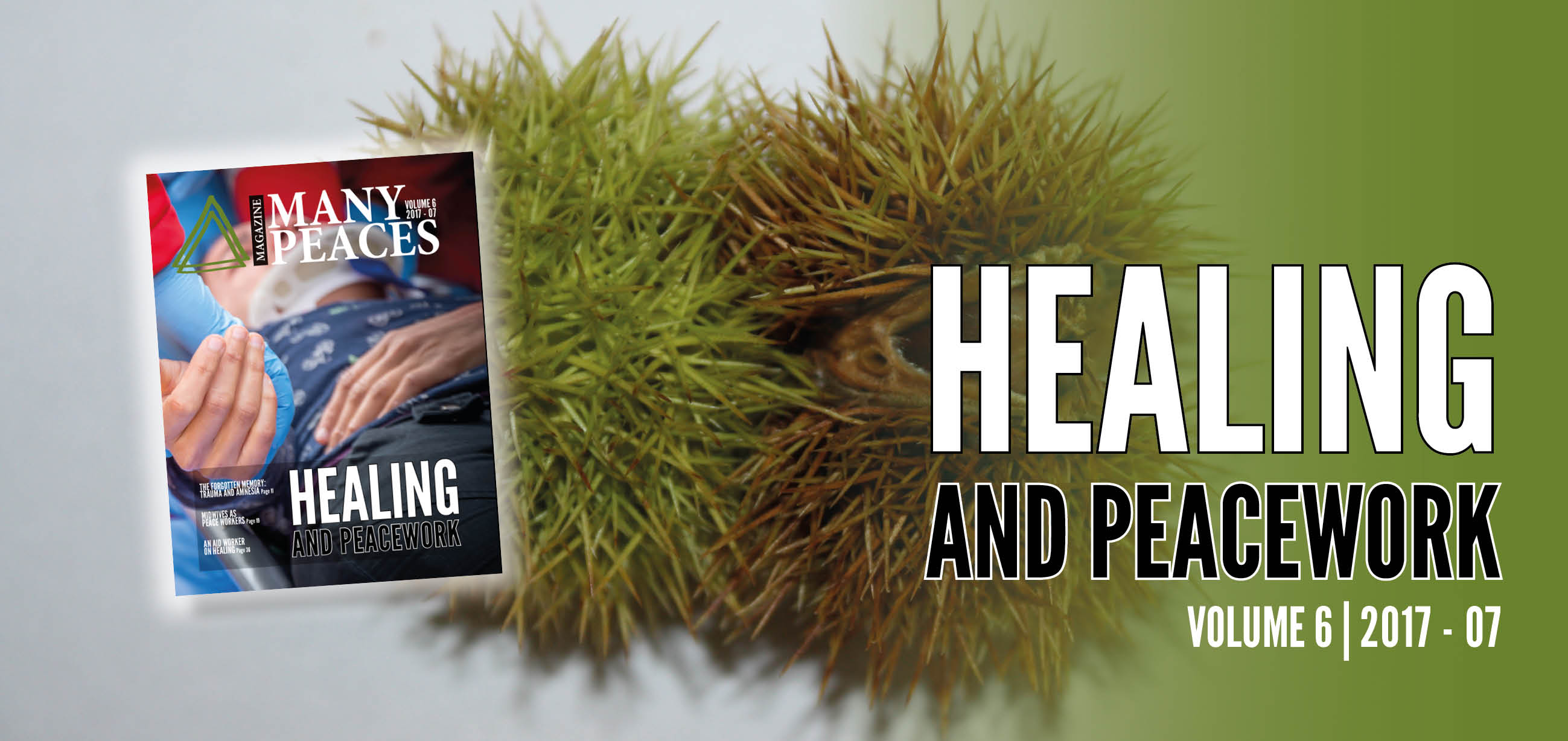Dear peace colleagues and friends,
I am very honored to have been chosen to write this greeting note for the sixth volume of the Many Peaces Magazine and to introduce to you, dear readers, the many very personal, touching and inspiring articles. They truly are heartfelt, strongly written honest pieces of work. By displaying different approaches to healing, the authors are challenging the readers to take steps reaching out towards those things creatively. I would also like to address a special thanks to those who passionately put effort, love and creativity into the Many Peaces Magazine again and again. Thanks for your engagement and for holding together the peace community!
My name is Karin Michalek and for five years I was working in the MA Program in Peace Studies at the University of Innsbruck as a student advisor and before that I was a student myself. So yes, I consider myself part of the Peace Studies family, which means a lot to me. And having the chance to do something for the community fills my heart with pleasure. At the MA Program I learned a lot, as student and as advisor, most of all the meaningfulness of relationships, wherein the experience of one influences the experience of the other. I learned that together we create a common field, where, potent healing moments are possible. Healing, understood as such, is deeply relational and personal and all the contributions to the current volume highlight this art of healing, the change and the transformational nature of being. Essentially, all the authors enhance their understanding of healing by telling us their personal stories and how we effect change and growth.
Theresa Gottschall and Marisa-Isabella Geiser express beautifully in their articles the Paradoxical Theory of Change, the heart of the Gestalttherapy. Simply put, the theory states that the more you try to be someone or something you are not, the more you will stay right where you are. Transformation – in this regard – happens by compassionately accepting what is, “by acknowledging my own wounds”, as Marisa states, “I let them heal”. Or in Theresa’s words: “Looking at yourself with such honesty might not yet solve anything, but it is a step to become more aware of who you are.” Differently put, we move by standing still in acceptance.
Isabelle Guibert’s contribution to the current volume focuses on amnesia as a possible response to trauma. Thereby, it highlights the importance of integration and wholeness, and raises the following questions: When and why do survivors of traumatic experiences come out of amnesia? What breaks their inner silence? For Isabelle, healing means “traversing the pain of trauma again in order to integrate what happened, put it back there where it belongs to, so as to finally get to one’s real Self, that is, be Oneself”. Healing, in her perspective, thus implies a constant process of integration without which the feeling of separation, void, and incompleteness creates more shadows that fuel the sense of deficiency. Since we, as individuals, are driving for complete experiences, the gist is the integration of “as many puzzle pieces as possible for transformation, hence healing, to begin”.
Jaime Tilston shares thoughts and feelings about her time in hospital, diagnosed with cancer and demonstrates how unconditional love, intention and positive energy as peaceful healing techniques nurtures her healing journey. Thich Nhat Hanh once suggested, when we are with someone who is in pain, we might offer this deeply healing message: Darling, I care about you suffering. And within Jaime’s reflection this care and tenderness, this love from her beloved ones all over the world had a huge impact on her wellbeing. The experience of connection and caring for another was the blessing of a heart that was opening. For Jaime healing is rebirth, an opportunity to live and to improve the quality of life.
Lawal Seun Isaac’s contribution highlights Jaime’s healing process through relatedness and belonging. The heart of his article ‘The Prowess of African Traditional Healing Methods’ evokes a holistic worldview of indigenous African cultures, where life itself is spiritual and all aspects of reality in the seen and unseen world work together. The relationship with nature then creates the desired inner balance in us. “Eventually we recognize ourselves as a part of nature which can have tremendous soul-healing benefits”, as Seun stated. “Each of us carries a connection, which we continuously need to renew.”
Heela Najibullah addresses in her article the importance and relevance of social healing in reaching sustainable reconciliation in conflict-affected societies, in this case Afghanistan. She reflects on her own personal process, which holds a great potential for social healing and transformation. “By changing oneself”, she stated, “we have the possibility to change one’s nation and the world around us.” In my perception Heela illustrates vividly the concept of an elicitive approach to conflict transformation, by revealing the systemic understanding of the self-healing creative potential of the context.
Similar to the portrait of Heela’s understanding of elicitive peace work, Judith Otter tells us in her article about the meaning of midwives as peace workers. When she says that she sees her role in holding safe spaces, incorporating theoretical and embodied knowledge, clinical skills, deep listening, intuitive judgment, spiritual awareness and personal experience, I immediately associated those qualities with facilitating Holotropic Breathwork sessions. Holding space for someone means that we are willing to walk alongside another person in whatever journey they are on without judging, interfering, let it happen, in and through themselves. When we hold space for someone we open our heart, offer unconditional support and let go of judgment and control. And those qualities I consider as the art of elicitive peace facilitation.
From the wisdom of ancient cultures to modern psychology, Johannes Ludwig creates a bridge of understanding between the practice of meditation, yoga, body oriented methods and constellation work (constellation of the intention/trauma constellations). Johannes describes in his article how everyone can learn to integrate body, mind and soul to facilitate a creative synchrony of healing and wellbeing. Deep healing, means to him, to connect with one’s essence, a process, which starts with non-resistance to what is.
Marie-Josée Ryan presents another example of elicitive peacework. She is working as a physiotherapist in a multidisciplinary team that empowers injured workers to shift from a pain-focused situation to a productive and functional lifestyle. In her article, she emphasizes the meaning of a trusting and supportive team and the importance to engage compassionately with others. She witnesses that healing occurs through interconnectedness and she strives to practice that every day.
From the perspective of an aid worker, Gernot Grömer, a dear friend and an indispensable partner of the MA Program, “healing is the result of an attitude, of how much the person wants to be healed.” Interviewed by Alexa Cuello, Gernot challenges the readers to enlarge their understanding of healing with a medical perspective. He focuses on the paradigm shift of care in emergency medicine and is envisioning future steps in the cooperation with the Peace Studies.
Altogether the current volume of the Many Peaces Magazine illustrates beautifully, both the variety and the uniqueness of healing moments. Etymologically healing means “to make whole” and this wholeness making, as C.G. Jung stated, is a creative expression of individuality.
I invite you, dear reader, to dip into exactly that: The many creative expressions of healing moments. Enjoy!

